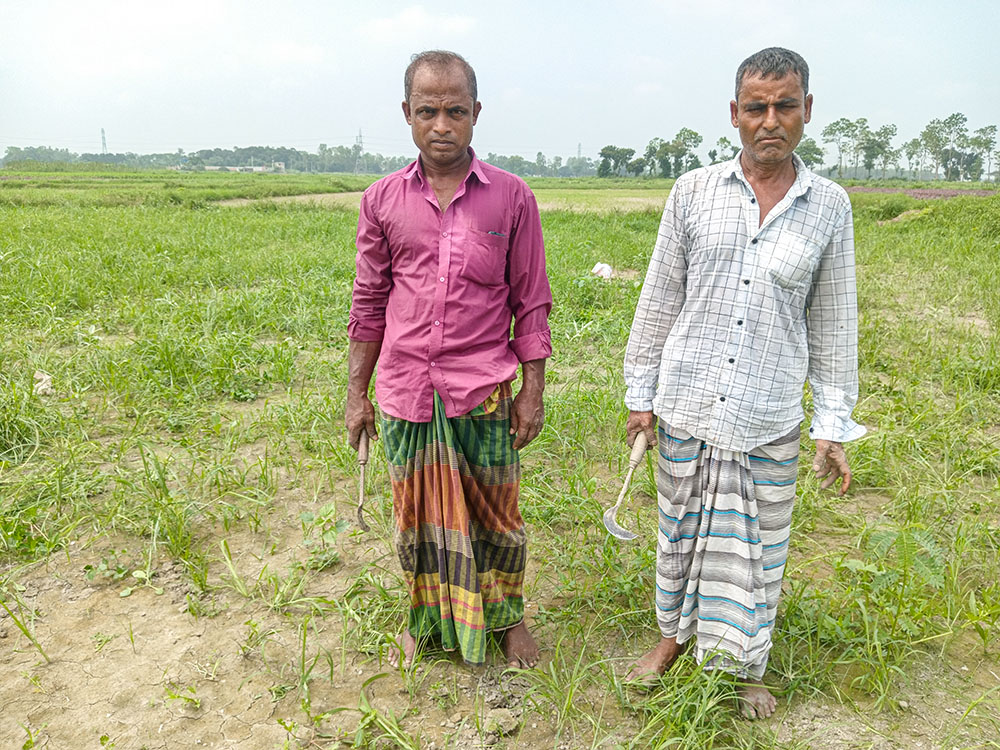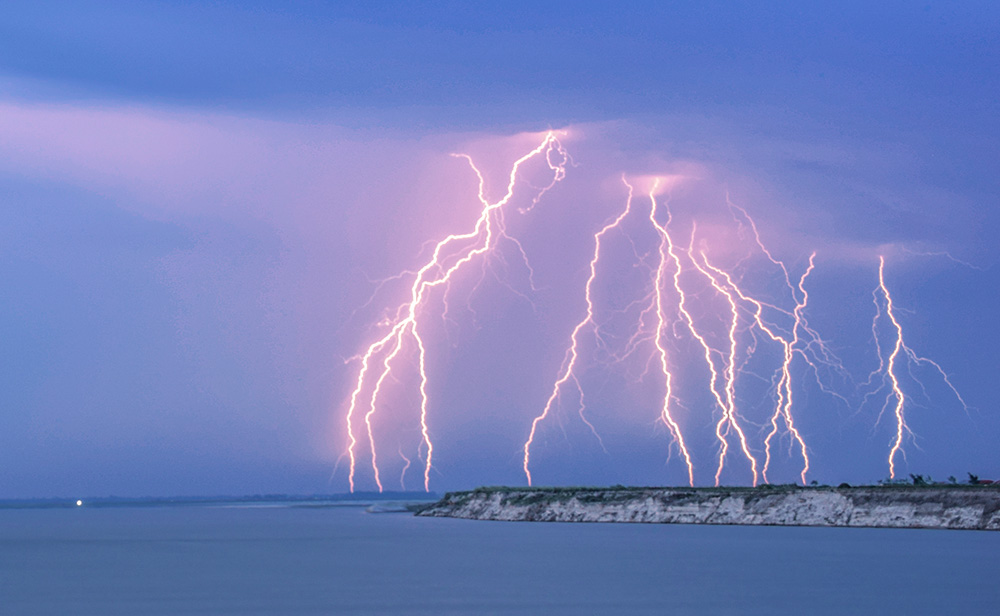
Boniface Khonglah (fourth from left), the regional director of Caritas Sylhet Region, alongside other local leaders, visits the lightning protection shelter at Panchauniya Haor in the Baniachang subdistrict of Habiganj district, Bangladesh, Jan. 17. (Courtesy of Caritas Bangladesh)
Ziaul Haque, 50, a farmer from Langadu subdistrict of Rangamati in southeastern Bangladesh, was the sole income-earning member of his family. On June 15, while returning from the local market by boat on Kaptai Lake with food for his family, he was struck and killed by lightning. Three more people also died from lightning strikes in the same area.
On June 19, two people lost their lives in separate lightning incidents during a rainstorm in Bagerhat, southwestern Bangladesh. These incidents occurred in the villages of PC Dema and Hedayetpur in the Sadar subdistrict.
According to family members, one of the deceased, Saidur Rahman, 27, had taken cows from his home in the morning to graze in the nearby Panchamala field. It started raining heavily in the afternoon and Rahman attempted to return home with them. When he was struck by lightning, he died instantly. Ujol Rahman, who was with him, was seriously injured. Three of the cows and one buffalo were also killed.
Abdul Mannan, 80, a resident of Bolipur in Savar, near Dhaka, died from lightning strikes on Aug. 20, 2022. He was working in a crop field at the time.

Sorafat Ullah, 55, an inhabitant of Bolipur of Savar, works in a crop field on June 21. Ullah lost his father Abdul Mannan, 80, in lightning strikes on August 20, 2022. (Sumon Corraya)
His son, Sorafat Ullah, told EarthBeat, "The sky was covered by a black cloud. After it started raining, my father couldn't return home as he was an elderly person. He died due to lightning strikes."
The 55-year-old farmer said they were unaware of the risks posed by thunderstorms. "Nobody taught us about the dangers of lightning strikes. If my father had known, he might not have stayed outside during the rain," said Ullah, who is now more aware of such risks.
One of Bangladesh's deadliest lightning strike incidents occurred on the Padma River in the Shibganj subdistrict of Chapainawabganj, northwestern Bangladesh, on Aug. 4, 2021. In the morning, a boat departed Chapainawabganj for Shibganj's Dakshin Paka village, carrying a bridegroom. Around 12:30 p.m., when the boat neared Shibganj, it was struck by lightning, damaging the boat and killing 16 people. Several others were injured and admitted to the subdistrict Health Complex.
An average of 300 people in Bangladesh die every year due to lightning strikes, according to the United Nations. This figure is significantly more than lightning strike deaths in countries like the United States, where the annual average is fewer than 20 people.

Abdul Mannan, 80, an inhabitant of Bolipur of Savar, died in a lightning strikes on August 20, 2022. His sons, Sorafat Ullah, left, and Mojib Ullah work in their crop field on June 21. (Sumon Corraya)
Experts say thunderstorm-related deaths are increasing in Bangladesh due to changing weather patterns, more lightning, and deforestation that has cut down tall trees that could absorb the impact of strikes. They believe it is possible to prevent these deaths by raising awareness and adopting the appropriate initiatives.
In August 2015, the government declared lightning strikes a disaster in response to the increase in related deaths. Several projects were initiated to prevent deaths due to lightning, one of which was the planting of palm trees. The disaster management department was supposed to plant 4 million palm trees under this project, but it failed to achieve this goal.
A freelance consultant in disaster risk management and climate adaptation, who is also adjunct faculty at the Institute of Disaster Management and Vulnerability Studies at the University of Dhaka, recommended planting tall trees throughout the country as a simple solution. "We are not protecting the old trees. Even when trees are destroyed, no action is taken against it. So, where will the protection come from?" said the consultant, who wished to remain anonymous.

A thunderstorm is seen over the Jamuna River in Bangladesh. (Dreamstime/Rasel Ahmmed)
Gauhar Naeem Wara, a distinguished writer and researcher, emphasized that stopping the cutting of palm trees is crucial. "Cutting fresh palm trees should be stopped in our country. The Narail District Commissioner could save 1,600 palm trees a year if he wished. People make boats from palm trees, and this should be stopped by the authorities," he said.
He also mentioned that field workers in Nepal and India who worked with farmers who survived lightning strikes found that farm laborers who wore rubber shoes survived significantly more often than those who were barefoot. "If that's the case, why not pay attention to providing shoes rather than installing expensive bars like lightning arresters?" he said.
The Catholic Church in Bangladesh has responded to the recent surge in lightning-related deaths with a different approach than protecting and planting trees or providing protective footwear. Caritas Bangladesh, the social arm of the Catholic Church, has established a lightning protection shelter through the Family and Community Level Flood Preparedness Project at Panchauniya Haor (wetland) in the Baniachang subdistrict of Habiganj district.

Fishermen and their children take shelter in a lightning protection shelter at Panchauniya Haor in the Baniachang subdistrict June 13. (Courtesy of Caritas Bangladesh)
Abu Taher, junior program officer of disaster management at the Caritas Sylhet Region of Caritas Bangladesh, told EarthBeat that many farmers and fishermen go to the Panchauniya wetland in Baniachang. When rainstorms occur, "people are using our lightning protection shelter. Earlier, people stayed under the open sky at risk of lightning," he explained.
"In Baniachang subdistrict, in the last five years, 59 people have died due to lightning strikes," Taher said. In December 2023, Caritas Bangladesh inaugurated the shelter, and so far, 380 farmers and fishermen have taken shelter there during rainstorms.
Baniachang subdistrict's project operation officer, Maloy Kumar Das, approved the lightning protection shelter project of Caritas Bangladesh and praised the initiative.
Catholic Boniface Khonglah, the regional director of Caritas Sylhet Region, said the introduction of the lightning protection shelter marks a key and commendable initiative by Caritas Bangladesh. "This project highlights Caritas' commitment to resilience and community protection, marking a significant step toward sustainable development and humanitarian excellence. Habiganj is a hotspot for lightning strikes. Each year, many people die due to lightning strikes. To save them, we have taken this small project," he told EarthBeat.
Advertisement
Local people of Baniachang subdistrict expressed gratitude to Caritas Bangladesh for establishing the shelter. "Earlier, we feared staying in the wetland when it rained. Now we move to the shelter, which is safe and secure. We are thankful to Caritas," Mamun ur Rashid, a fisherman who lives in Kumri village in Baniachang, told EarthBeat. The 45-year-old also said that one of his relatives, who was the only income-earner for his family, died in the wetland last year.
Additionally, some Catholic priests in Bangladesh are raising awareness about thunderstorms. Fr. Dominic Halder, a priest at Bagerhat Catholic Church in the Khulna Diocese, told EarthBeat, "Our people are not very educated and don't know much about thunderstorms, so I advise them not to stay outside during rain to save them from thunderstorms."
"I believe this shelter is a blessing for us, as our house is 2 kilometers away from the wetland," said Rashid.








